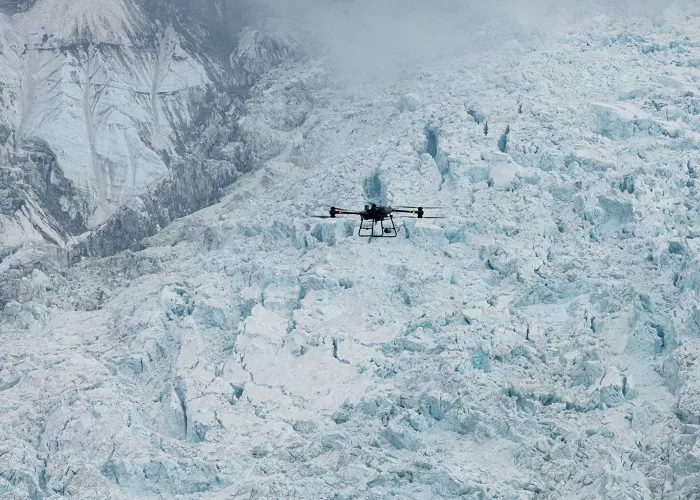A Nepali drone company is changing how supplies are delivered on Mount Everest, aiming to make climbing the world’s tallest mountain safer and more efficient. After successful test flights last year, the company, Airlift, is ready to begin regular drone deliveries between Everest Basecamp and higher-altitude camps.
Using DJI FlyCart drones, Airlift will transport essential gear like oxygen bottles and medicines, assist Sherpas in scouting routes, and even carry trash down the mountain—helping to solve Everest’s growing waste problem.
Successful Tests at High Altitudes
The idea isn’t just theoretical. Last year, Airlift ran test flights that proved drones could handle the extreme environment. In one trial, a drone flew three oxygen bottles and 1.5 kilograms (about 3.3 pounds) of supplies from Everest Basecamp—already 17,000 feet above sea level—up to Camp 1, which sits close to 20,000 feet. On the way back, the drone brought down trash, demonstrating its potential to help clean up the mountain.
Safer Navigation Through the Khumbu Icefalls
One of the most dangerous areas on the way to Everest’s summit is the Khumbu Icefalls. This stretch is filled with moving ice, deep crevasses, and unstable terrain. Traditionally, Sherpas carry loads through this area by hand—a job that puts their lives at constant risk.
While helicopters could technically handle supply deliveries, they are too expensive and risky in the thin air and freezing temperatures. Drones offer a more sustainable and safer solution.
Drones Support, But Sherpas Still Lead
The use of drones doesn’t replace Sherpas. Instead, it supports them. Milan Pandey, the lead pilot operating the DJI drones, explained how the system works. Sherpas use their experience to identify the best paths and the areas that need extra tools like ladders or ropes. They then radio Pandey with the exact locations, and he sends the drones to deliver the needed gear.
This system helps reduce how often Sherpas need to make the same dangerous trip up and down the mountain. It also allows them to move faster and more safely.
Drones can also fly in life-saving supplies like oxygen tanks and medical items, which could make a critical difference during emergencies.
A Tragic Inspiration
The push for drones on Everest was inspired by tragedy. Mingma G Sherpa, founder of the mountaineering group Imagine Nepal, lost three close friends in an avalanche. Their bodies were never recovered.
Mingma said his friends had to climb the mountain over and over again just to plan the route and then return to get the right equipment. After hearing about how drones were being used to help on mountains in China, he thought, “Why not here?”
That question sparked a change. Today, Airlift’s drones are starting to do exactly what Mingma hoped: reduce the risks for the Sherpas who make Everest climbs possible.
A New Era for Everest Climbing
With drone technology now proving its worth at extreme altitudes, Everest may be entering a new era—one where climbing is still challenging, but a little less deadly. The addition of drones not only supports the Sherpas but also helps clean up the mountain and reduce environmental damage.
While climbing Everest will always require courage, strength, and skill, tools like these could help save lives and protect the mountain for generations to come.


